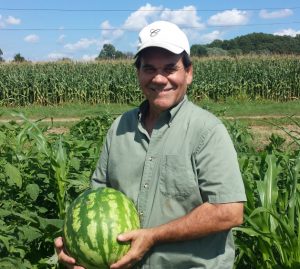Steven DarceyUpper Marlboro, MD
 Steven Darcey
Steven Darcey
Edgewood Farm
Prince George’s County, Maryland
Prince George’s Soil Conservation District
My name is Steven Darcey and I am a 4th generation Prince George’s County farmer. I began working as a soil conservation engineer for the Prince George’s Soil Conservation District in 1986 and became the District Manager in 2013. My parents, Roland and Mildred Darcey, purchased Edgewood in 1956 and were both steadfast advocates for farmers on a local, state, and national level. In 1991, the Darcey family was one of the first three Maryland farm families to be inducted into the Governor’s Agriculture Hall of Fame. As longtime cooperators with the Prince George’s Soil Conservation District, Edgewood Farm was awarded the 1995 Conservation Farm of the Year and became certified in Maryland’s Farm Stewardship and Assessment Program (FASCP) in 2012.
The Edgewood Farm has gone through changes since the 1950s, from tobacco, beef, hay, straw, and silage corn to primarily corn and soybeans. In additionto commerical grain, my wife Bonnie owns and operated Edgewood Farm Stables, an English hunter show horse boarding facility. Edgewood Farm is 150 acres total with approximately 10 acres in homesteads and farmsteads, 60 acres in forests, meadows, and natural areas with 10 acres in pasture and 70 acres of cropland. Both farms have highly productive fine sandy loam soils of the Collington soil series with slopes ranging from 1 to 8 percent.
The farms are bisected by an unnamed tributary of Turkey Branch that flows eastward into Western Branch, a major tributary of the Patuxent River. The Patuxent River is of great significance because it is one of the ten major Maryland tributaries of the Chesapeake Bay. Historically, the entire farm operation had been clean tilled until the middle 1990s. At that time, I changed over to all no-till grain and no-till pasture renovation system. My main reason for switching to no-till farming was to improve efficiency (working a full-time job restricts the amount of time spent on the farm). As it turned out, it also saved money and greatly reduced soil erosion. There are cool season grass filter strips along all lower edges of the crop fields, and the stream is protected on both sides with a combination of warm season grasses, cool season grasses, and riparian forest buffers. These best management practices (BMPs) were installed with support from the USDA’s Conservation Reserve and Enhancement Program.
Other soil health related BMPs include no-till planting, crop residue management, crop rotation, and winter cover crops following corn harvest. I have also participated in some of the University of Maryland’s deep root cover crop trials on the farm. This year I plan to experiment with more diverse winter cover crops, such as tillage radishes and crimson clover.
Throughout the 1980s and 90s I had routinely field spread all of the horse manure from the boarding operation. Of course the field closest to the stable received the bulk of the manure. After some time, I noticed a tremendous reduction in crop yields as a result of soil compaction and greater weed pressure caused by applying non-composted horse manure that contained hay and weed seeds. It was at this time that I began to stockpile my manure and educate myself on composting. After completion of the University of Maryland’s Better Composting School, I became certified in composting with the Maryland Department of Agriculture. I have been successfully composting all of my horse manure since 2001 and turning it into a profitable on-farm value added product.
The best results of using soil health practices are the increased yields and reductions in soil erosion. We’ve also noticed improved farm aesthetics and increases in wildlife populations. Unfortunately, more deer pressure has meant more crop damage, but the natural cover has also provided improved bird and upland game habitat. As we learn more about the interaction of different natural systems, we have adopted more “no mow” areas on the farm and increased our pollinator habitat plots. Warm season grass buffers are beautiful but the one challenge in Southern Maryland is the weed and volunteer tree encroachment into these buffer areas. If not carefully monitored, trees and undesirable herbaceous plants like multi-floral rose, sweet gum trees, tree-of-heaven, and various thistles can proliferate.
Challenges
I believe the greatest challenge in this region is lack of knowledge on the behalf of producers. NRCS has led a tremendous effort to promote soil health and the NACD Soil Health Champion initiative will build on that process. Farmers witnessing each other’s successes is a powerful tool.

